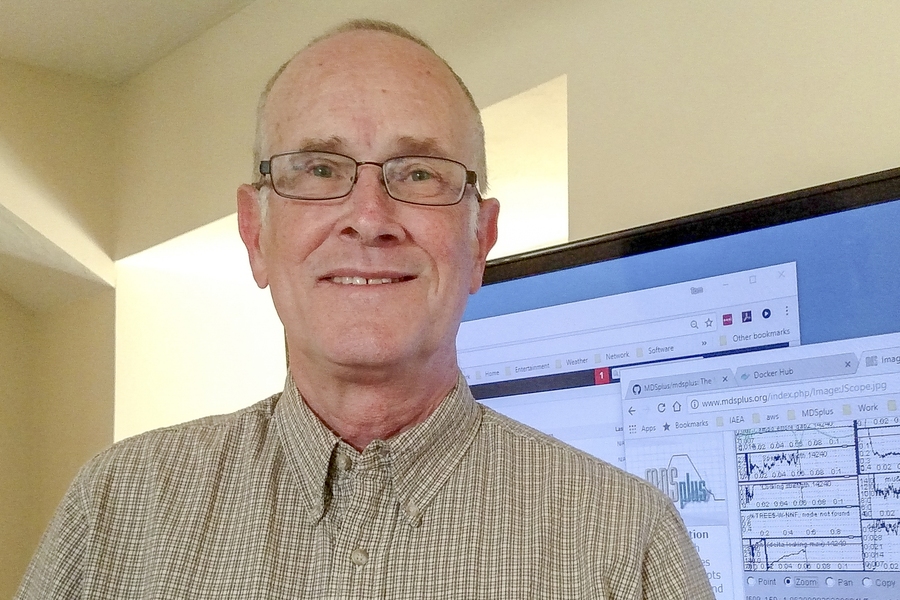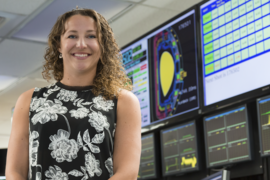Systems programmer and analyst Tom Fredian, who has worked at MIT’s Plasma Science and Fusion Center (PSFC) since 1982, credits a fork in his career road for leading to his deep interest in computers and software development.
That change in direction led to creating the go-to data software system for fusion research, MDSplus. Fredian is being recognized for this accomplishment by the Institute of Electrical Engineers (IEEE) Nuclear and Plasma Science Society with the Computer Applications in Nuclear and Plasma Sciences Award. The prestigious award, which is given out every other year, honors those who have made major contributions in the field of real-time computing in nuclear and plasma physics.
With a degree from Carnegie Mellon University, Fredian first worked as a chemical engineer at Dupont. Encouraged by management to explore stints at a variety of jobs, Fredian spent two years experimenting with ultraviolet absorbers and Polaroid film before transferring to a position at a Texas chemical plant. There, writing programs to measure and monitor energy consumption, he was introduced to Fortran, the scientific community’s first high-level programming language.
“I had only taken one computer course in college, but now I really started enjoying programming,” he says.
Fredian strengthened his skills during his next assignment, developing a process monitoring system for measuring temperatures and pressures of chemical processes. There he learned the value of providing general tools for the plant operators to collect and examine trend data. The tool set he created was eventually used at several different chemical plants within the company.
While Fredian valued his career at DuPont, after 10 years he welcomed a new opportunity at PSFC, providing computer assistance for the scientists and engineers at the Alcator-C fusion experiment. He quickly noticed that the scientists’ methods of acquiring and sharing data were cumbersome: They stored and retrieved data from magnetic drums, creating files whose signals were referenced by number, not name; they took Polaroid photographs of oscilloscopes and manually digitized the data; and they wrote their own programs to read data, storing them in files whose content could not be easily understood by others.
“If someone wanted data from someone else’s diagnostic, they would ask for it, and the researcher would print out a bunch of numbers and hand it over. I decided I could probably provide them with some better tools, so they could store their data in a central location and share it among the scientists.”
As he began designing some of these tools, Fredian met Josh Stillerman, who had been hired at the center in a similar capacity for a machine called TARA, a tandem mirror approach to magnetic fusion that has since been abandoned. Both tasked with finding solutions to data management, the colleagues decided to collaborate.
“Much to the dismay of some of the scientists,” Fredian notes. “Some researchers did not believe you could have the same system work for two different experiments.”
They began putting together a system for storing data acquired during the short pulse experiments of fusion devices, which would eventually become known as MDS.
The fusion world was quick to take notice of this new data acquisition and analysis system, and several labs from around the world began to use it.
The system took another leap forward when MIT began planning its next fusion project, the Alcator C-Mod. At the same time, the Fusion Research Group in Padua, Italy, was building a Reversed-Field Experiment and Los Alamos National Laboratory was exploring a machine called ZTH — both similar machines that would be able to use identical data systems. Together the three institutions worked on MDSplus, an enhanced system that would address the specific needs of these new devices. Although ZTH was cancelled before it could be built, the data system it helped expand is currently installed in over 30 sites spread over five continents.
Martin Greenwald, PSFC deputy director, notes that on the strength of its capabilities, MDSplus has become the de facto standard for data acquisition and data management in the fusion community. “The software incorporated a number of features that presaged later advancements in computer science,” he says. “For example, in MDSplus, data can be retrieved by simply referring to it by a globally unique name — similar to the principle that allows us to refer to information on the web via a URL. Tom’s contributions were exceptionally creative and far-reaching.”
The award recognizes Fredian’s “outstanding leading role in the development and evolution of data systems in nuclear fusion.” He will receive the award in June at the 21st IEEE Real Time Conference in Williamsburg, Virginia.
Fredian continues to consider how MDSplus might need to change and improve to serve future fusion devices.
“I’m hoping to get new, young people from different sites to join the team, “ he says. “New particpants have been joining from W7-X, the new stellarator in Germany, and from Italy. That new blood has a lot of enthusiasm — and great new ideas.”










